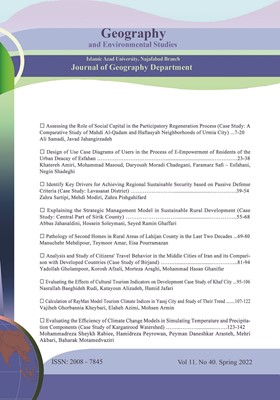-
-
List of Articles
-
Open Access Article
1 - Assessing the Role of Social Capital in the Participatory Regeneration Process (Case Study: A Comparative Study of Mahdi Al-Qadam and Haftasyab Neighborhoods of Urmia City)
Ali Samadi Javad Jahangirzadeh -
Open Access Article
2 - Design of use case diagrams of users in the process of e-empowerment of residents of the urban deacay of Isfahan
Khatere Amiri Mohammad Masoud Daruosh Moradi Chadegani Faramarz Safi - Esfahani Negin Sadeghi -
Open Access Article
3 - Identify key drivers for achieving regional sustainable security based on passive defense criteria (Case study: Lavasanat District)
Zahra Sartipi Modiri Mahdi Zahra Pishgahifard -
Open Access Article
4 - Explaining the Strategic Management Model in Sustainable Rural Development (Case Study: Central Part of Sirik County)
Abbas Jahanaldini Hosein Soleymani Ramin Ghaffari -
Open Access Article
5 - Pathology of Second Homes in Rural Areas of Lahijan County in the Last Two Decades
Manuchehr Mehdipour Teymoor Amar Eisa Pourramazan -
Open Access Article
6 - Analysis and study of citizens' travel behavior in the middle cities of Iran and its comparison with developed countries (Case study of Birjand)
Yadollah Gholampoor Korosh Afzali Morteza Araghi Mohammad Hasan Ghanifar -
Open Access Article
7 - Evaluating the effects of cultural tourism indicators on development Case study of Khaf city
Nasrolah Baaghide Katayoon Alizadeh Hamid Jaffari -
Open Access Article
8 - Calculation of RayMan model tourism climate indices in Yasuj city and study of their trend
Vajiheh Ghorbannia Kheybari elahe azimi mohsen armin -
Open Access Article
9 - Evaluating the efficiency of climate change models in simulating temperature and precipitation components (Case study of Karganrood watershed)
Mohammad Reza Sheykh Rabiee Hamid Reza Peyrowan Peyman Daneshkar Arasteh Mehry Akbary Baharak Motamedvaziri -
Open Access Article
10 - Analysis of the effects of biological environmental hazards on urban spaces with emphasis on Corona pandemic (Case study: Tabriz metropolis)
Hamideh Gholami Ali Panahi Hasan Ahmadzadeh -
Open Access Article
11 - Study and Evaluation of Temperature in Aleshtar City based on Artificial Neural Network Model
Mahnaz Hassanvand Reza Borna Manijeh Zohoorian Pordel Alireza Shakiba
-
The rights to this website are owned by the Raimag Press Management System.
Copyright © 2021-2025







